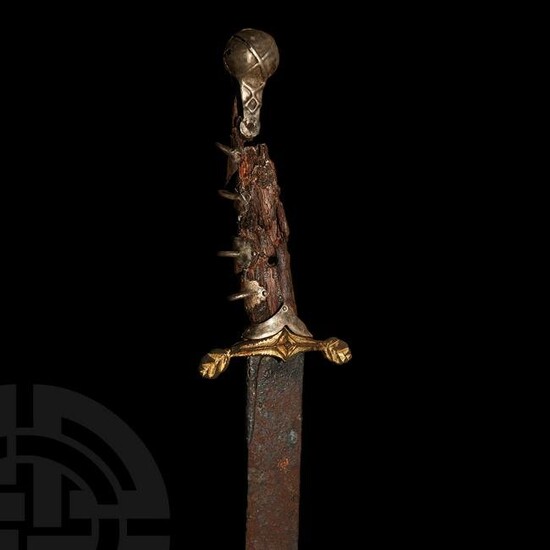Khazar Sabre with Silver Scabbard
Verchne-Szaltovo Culture, 9th-10th century AD. A hand-forged iron sabre with a wooden hilt and single-edged blade, the blade showing battle nicks, a welded band with a tapering extension extending to the cutting edge beneath the quillon; the ornamented gilt bronze quillon with foliate finials, central motif a raised lozenge, a silver cuff above, the wooden hilt with four silver side mounts and a bulbous sheet-silver pommel with X-motifs in relief; three parts of the silver scabbard preserved, including the finial. Cf. Zakharow, A., Arendt, W., Studia Levedica, Archaeologischer Beitrag zur Geschichte der Altungarn im IX JH., Budapest, 1935, fig.6, p.19 (hilt and scabbard), fig.7, p.20 (scabbard), fig.16, p.29 (scabbard), pls.II-III,VI, for nearly identical specimens; cf. Lebedinsky, I., Les armes orientales, Langres, 1992, p.59, fig.F, and pp.58ff.; cf. Fodor, I., Revesz, L., Wolf, M., Nepper, I.M., Morigi Govi, C., Gli Antichi Ungari, nascita di una nazione, Bologna, 1998, p.60; cf. Bashir, M., The Arts of the Muslim Knight, The Furusiyya Art Foundation Collection, Milan, 2008, pp.29ff. 650 grams total, 84cm long (33"). Private collection of Mr M.B., Mainz, Germany, 1990s. Property of a London businessman. Accompanied by an archaeological report by military specialist Dr. Raffaele D’Amato. This exceptional sabre shows similarities with examples from the Caucasus and Kuban regions. The blade could be Khazar-Magyar, and the best parallels for it are the specimens from the Verchne-Szaltovo area. According to M. Gorelik, some of these sabres were produced by the Kabarians, a breakaway tribe from the Khazar State, who formed an alliance with the Magyars. The practical device of the extra band welded beneath the quillon, together with the side extension, not only protected the scabbard from being cut by the blade, they defended the warrior’s fingers which were wrapped around the quillon when fighting. The four mounts of the hilt were another practical device, allowing the cavalryman a better grip on the weapon; the ring on the top of the pommel accepted a strap which would have been wrapped around the wrist of the warrior. [4]
Condition Report: Fair condition, fragmentary.
View it on
Estimate
Time, Location
Auction House
Verchne-Szaltovo Culture, 9th-10th century AD. A hand-forged iron sabre with a wooden hilt and single-edged blade, the blade showing battle nicks, a welded band with a tapering extension extending to the cutting edge beneath the quillon; the ornamented gilt bronze quillon with foliate finials, central motif a raised lozenge, a silver cuff above, the wooden hilt with four silver side mounts and a bulbous sheet-silver pommel with X-motifs in relief; three parts of the silver scabbard preserved, including the finial. Cf. Zakharow, A., Arendt, W., Studia Levedica, Archaeologischer Beitrag zur Geschichte der Altungarn im IX JH., Budapest, 1935, fig.6, p.19 (hilt and scabbard), fig.7, p.20 (scabbard), fig.16, p.29 (scabbard), pls.II-III,VI, for nearly identical specimens; cf. Lebedinsky, I., Les armes orientales, Langres, 1992, p.59, fig.F, and pp.58ff.; cf. Fodor, I., Revesz, L., Wolf, M., Nepper, I.M., Morigi Govi, C., Gli Antichi Ungari, nascita di una nazione, Bologna, 1998, p.60; cf. Bashir, M., The Arts of the Muslim Knight, The Furusiyya Art Foundation Collection, Milan, 2008, pp.29ff. 650 grams total, 84cm long (33"). Private collection of Mr M.B., Mainz, Germany, 1990s. Property of a London businessman. Accompanied by an archaeological report by military specialist Dr. Raffaele D’Amato. This exceptional sabre shows similarities with examples from the Caucasus and Kuban regions. The blade could be Khazar-Magyar, and the best parallels for it are the specimens from the Verchne-Szaltovo area. According to M. Gorelik, some of these sabres were produced by the Kabarians, a breakaway tribe from the Khazar State, who formed an alliance with the Magyars. The practical device of the extra band welded beneath the quillon, together with the side extension, not only protected the scabbard from being cut by the blade, they defended the warrior’s fingers which were wrapped around the quillon when fighting. The four mounts of the hilt were another practical device, allowing the cavalryman a better grip on the weapon; the ring on the top of the pommel accepted a strap which would have been wrapped around the wrist of the warrior. [4]
Condition Report: Fair condition, fragmentary.



